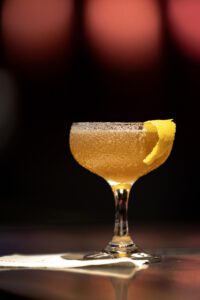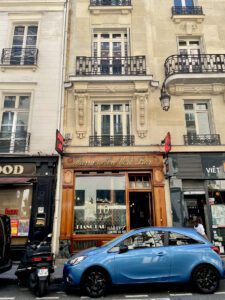Take a classic for a spin.

Like the little black dress, the sidecar cocktail is timeless and effortlessly elegant. It has no season. It’s adaptable: refreshing on a sunny day and rich and comforting on a chilly winter’s eve. Bartenders, both professionals and at home mixers, can easily pull the cocktail together with little fuss. That, along with its delicious balance, is why it remains a classic a century after its inception.

The sidecar became popular when cocktail culture was emerging in places such as London and Paris. Travel, migration and even war reshaped the bar landscape. As with many famous drinks, origins are disputed, and many claim ownership. Such is the case with the sidecar.
With a recipe consisting of Cognac, triple sec and lemon juice, the sidecar first appeared in print in Harry MacElhone’s Harry’s ABC of Mixing Cocktails in 1919. As the tale goes, at the end of WW1, an American soldier ordered a brandy crusta at Harry’s New York Bar in Paris. The cocktail of brandy, Curaçao and lemon has roots in 1860s New Orleans, where the soldier would soon return. This being France, the bartender swapped Cognac for brandy and Cointreau for Curaçao, and named it for the motorcycle attachment in which the army captain was customarily driven.
Buck’s Club in London also lays claim to the sidecar with an origin story of bartender Pat McGarry serving up the drink. The creation yarn is much the same as the Paris tale, with a soldier friend arriving in a sidecar. As dubious as origins are, so are the ratios. The French mix up equal parts Cognac, orange liqueur and lemon juice, while the English way calls for two parts Cognac to one each of orange liqueur and lemon juice.
The brilliance of this cocktail is that you can change ratios to match preference, whether strong, tart or sweet. You can tinker with proportions, and alternative ingredients can be used. Brandy, Cognac and Armagnac easily interchange as the base spirit. Cointreau has that perfect blend of dryness and sweetness, but triple sec, Curaçao and Grand Marnier also do the job.

At The Painted Pin, the sidecar takes the bowling, Ping-Pong and Skee-Ball experience up a notch. A game of indoor bocce becomes refined with a luminous, golden-hued sidecar. Their version uses Cognac, triple sec and lemon juice, and has a sugared rim, much like the drink’s forefather, the brandy crusta.
Taking the journey to La Grotta’s concealed Buckhead dining room almost feels like an excursion to a speakeasy, where one would have to drink a sidecar during its heyday during the 1920s Prohibition era. La Grotta adds an appropriate Italian spin. The Tuaca Sidecar has a base of Tuaca, an Italian blend of brandy, Mediterranean citrus and vanilla spice, along with Cointreau and freshly squeezed lemon juice.
To go along with the gracious service at The Capital Grille, the Blackberry Bourbon Sidecar gets a twist that feels Southern. A swap of Woodford Reserve Bourbon for Cognac plays well with dry aged steak but also drinks like a porch sipper with the addition of Cointreau, blackberries, lemon juice and thyme.
Sidecar
Serves 1
INGREDIENTS
1 ½ ounces Cognac
¾ ounce Cointreau
¾ ounce fresh lemon juice
Lemon or orange peel or twist for garnish
INSTRUCTIONS
Add all ingredients to a shaker filled with ice. Shake until chilled, about 10 seconds. Strain into cocktail glass. Garnish with lemon or orange peel/twist, if desired.
THE CAPITAL GRILLE
thecapitalgrille.com
@thecapitalgrille
LA GROTTA
lagrottaatlanta.com
@lagrottaatl
THE PAINTED PIN
thepaintedpin.com
@thepaintedpinatl















